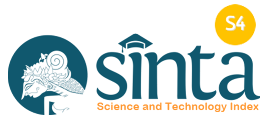OPTIMALISASI INLISLite DALAM TEMU KEMBALI INFORMASI DI DINAS PERPUSTAKAAN DAN KEARSIPAN KOTA PAYAKUMBUH
DOI:
https://doi.org/10.24269/pls.v7i1.7226Abstract The main problem in this thesis is the existence of obstacles encountered in information retrieval by users using the INLISLite software at the Payakumbuh City Library and Archives Service. The purpose of this study was to find out how to optimize information retrieval facilities in the information retrieval process by users at the Payakumbuh City Library and Archives Service. This type of research is a mixed methods method with a descriptive approach and a type of field research. Data collection techniques through observation, interviews and documentation. Data analysis techniques start from data reduction, data presentation and drawing conclusions. Guarantee the validity of the data in this study using source triangulation and technique triangulation. The results of the study show that (1) the performance and system coverage of the INLISLite software in the information retrieval process are good. The ability of the INLISLite software to find only the information needed is good, this result can be seen from the search results using the recall formula and the search results table which shows that the relevance of the documents found is 100% and fully relevant. The time needed by the INLISLite software to find the required information is fast. The average search time is 3.83 seconds. (2) Constraints in optimizing INLISLite software in information retrieval at Archives, namely the INLISLite software, especially the OPAC feature which can only be accessed using a special computer that has been provided and can also use a mobile phone but must log into the Payakumbuh City Library and Archive Service wifi.Â
References
Amin, Fatkhul. 2013. Sistem Temu Kembali Informasi dengan Pemeringkatan Metode Vector Space Model. Jurnal Teknologi Informasi DINAMIK 18 (2).
Amsyah, Zulkifli. 2003. Manajemen Sistem Informasi. Cetakan 4. Gramedia Pustaka Utama. Jakarta.
Fatmawati, E. 2020. Pengenalan Automasi Perpustakaan Terintegrasi INLISLite. Libraria : Jurnal Ilmu Perpustakaan dan Informasi 9(1): 1-9.
Roheni, H., & Marwa, N. (2018). Kualitas Pelayanan dalam Kepuasan Pelanggan. Ecodemica, Vol. 2, No. 2, 312-318.
Jhon, W. C. 2010. Research Design: Pendekatan Kualitatif, Kuantitatif dan Mixed. Ed. 3. Yogyakarta.
Naibaho, R. S. 2017. Peranan dan Perencanaan Teknologi informasi Dalam Perusahaan. Jurnal Warta 52.
Purbasari, A. &. (2019). Penilaian Beban Fisik Pada Proses Assembly Manual Menggunakan Metode Fisiologis. SIgma Teknika, 2, (1), 123-130.
Putung, K. D. 2016. Penerapan Sistem Temu Kembali Informasi pada Kumpulan Dokumen Skripsi. E-Journal Teknik Informatika 8 (1).
Rasefta, R. S. dan S. Esabella. 2020. Sistem Informasi Akademik SMK Negeri 3 Sumbawa Besar Berbasis Web. Jurnal Jinteks 2 (1).
Rifai, A. 2019. Penelusuran Literatur. Edisi 1. Cetakan 4. Cv Beringin Indah. Tangerang Selatan.
Downloads
Published
How to Cite
Issue
Section
License
Licence
This Journal will place Author as Copyright Holder, The non-commercial use of the article will be governed by the Creative Commons Attribution license as currently displayed on Creative Commons Attribution-NonCommercial-ShareAlike 4.0 International License.

Author(s)' Warranties
The author warrants that the article is original, written by stated author(s), has not been published before, contains no unlawful statements, does not infringe the rights of others, is subject to copyright that is vested exclusively in the author and free of any third party rights, and that any necessary written permissions to quote from other sources have been obtained by the author(s).
Plagiarism Notice
PUBLIS Editorial board recognizes that plagiarism is not acceptable and therefore establishes the following policy stating specific actions (penalties) upon identification of plagiarism/similarities in articles submitted for publication in PUBLIS. PUBLIS will use Turnitin's originality checking software as the tool in detecting similarities of texts in article manuscripts and the final version articles ready for publication. A maximum of 30% of similarities is allowed for the submitted papers. Should we find more than 30% of the similarity index, the article will be returned to the author for correction and resubmission.

_baru.png)










